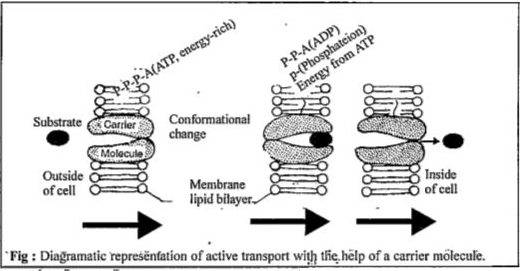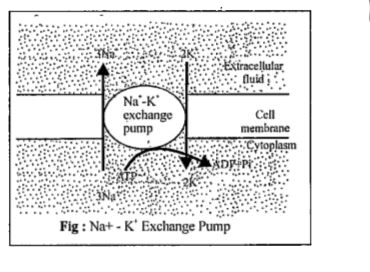Describe the mechanism of active transport across cell membranes.
Text Solution
Active Transport : It is a made of transport across the cell membrane which is againsts concentration gradient and require energy. Active transport is usually against chemical or electrochemical gradient. This energy is obtained from ATP. Active transport is far more rapid than passive transport. It is influence a number of factors which influence respiration. For example, deficiency of oxygen, presence of cyante low temperature, etc.
(i) Carrier Particles : Passage is given to ions and molecules by means of special organic molecules called carrier particles or proteins. The carrier combines with the ion or molecule at the surface of the membrane to form carrier solute complex. The complex moves to the other surface of the membrane and breaks to release the solute. Energy is required to either release or combine the solute with the carrier.


(ii) Sodium potassium Pump : It is a mode of primary active transport which operates at the plasma membrane to create a resting potential in nerve fibres, a membrane potential in other cells and induce secondary active transport (for passage of glucose, lastose, amino acide, etc.). Na+−K+ pump operates with the help of protein ATP-ase. The latter is also an enzyme which breaks ATP to release enlease energy. The energy is used in driving out Na+ and pumping in K+ion. For every ATP molecule used, three Na+ ions are driven out and two K+ ion are driven in. This helps in maintaining a positive potential and high Na+ concentration outside the cell.
(iii) Gated channels : They are passage ways for solutes in the cell membranes which normally remain closed but are opened by specific activators.
(a) Voltage Gating : Change in electric potential causes opening and closing of channel gates. Absence of negative charge on innerside of membrane causes Na+ channels to open for bringing Na+from extracellular fluid to in side of the cell. K+ channels open when the charge is reversed.
(b) Chemical Gating : Chemical combines with gate protein resulting in its opening or closing. For example, Calcium channel.
(iv) Secondry Active Transport: A large concentration of actively resulting transport material may cause reverse movement which also transports other substances as well. The phenomenon is called secondary active transport. It is of two main types, co-transport (e.g., inward passage of glucose and some amino acids alongwith inward pushing of excess Na+) and counter transport (e.g., outward movement of Ca2+ and H+ as excess Na+ passes inwardly).
|
Similar Questions
Knowledge Check
Active transport across biomembrane involves
AProduction of ATPBRequirement of energyCProduction of toxinDRelease of energyThe main difference between active and passive transport across cell membrane is that
APassive transport is non-selective wherease active transport is selectiveBPassive transport requires a concentration gradient across a biological membrane whereas active transport requires energy to move solutesCPassive transport is confined to anionic carrier proteins whereas active transport is confined to cationic channel proteinsDActive transport occurs more rapidly than passive transportThe main difference between active and passive transport across cell membrane is that the
APassive transport is activeBActive transport is passtiveCPassive transport is gradient based, while active transport is energy based against concentration gradientDPassive transport is confined to anions, while active transport is for cations only
The main difference between active and passive transport across cell membrane is :
View SolutionCarrier molecules facilitating transport across cell membrane are
View SolutionThe main difference between active and passive transport across cell membrane is that
View SolutionCarrier molecules facilitating transport across cell membrane are
View SolutionWhich one is not connected with transport across the cell membrane
View Solution
